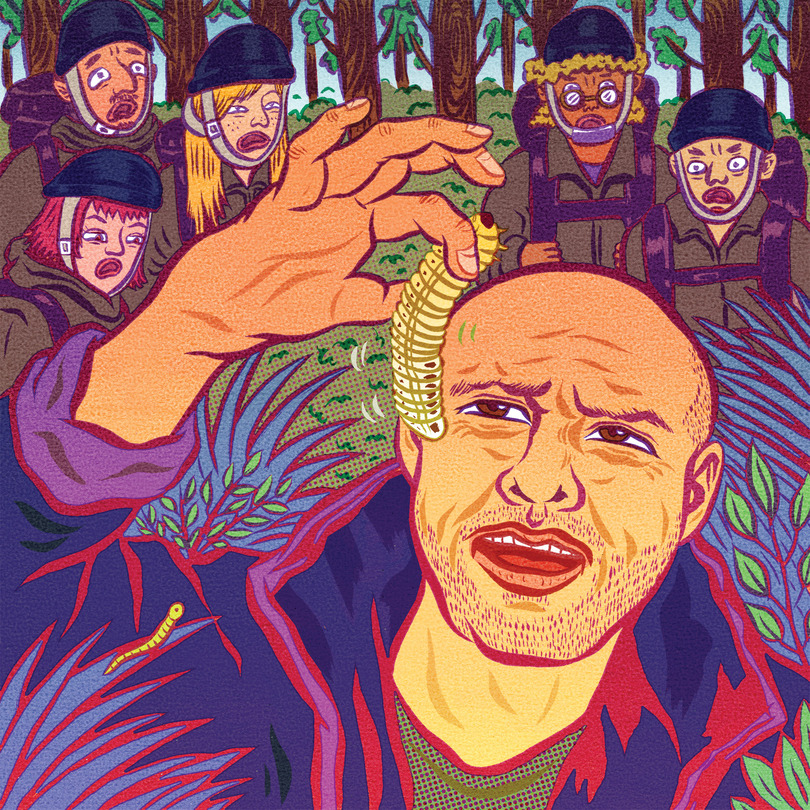The Local newsletter is your free, daily guide to life in Colorado. For locals, by locals.
Surrounded by the indian peaks wilderness, Matt Bragg hunches over a fallen tree, his nose just inches from the rotting wood. The former Royal Marine is hunting for our next meal: grubs. Meanwhile, I’m praying those slimy little larvae (which Bragg informed me pack more protein, pound for pound, than steak) wriggle out of sight, far from Bragg’s prying fingers. Judging from the horrified looks around me—my partners in misery on Colorado’s new Bear Grylls Survival Course, led by Grylls’ proxy Bragg—I’m not alone in my silent plea. “Ah ha,” Bragg says as he yanks out a plate’s worth of yellow grubs. You can almost hear a collective ugh. 
The collective, in this case, is made up of 15 brave (read: crazy) Coloradans who signed up for the Bear Grylls Survival Academy’s 24-hour adult survival course, which debuted in Colorado one year ago. Trading on the success of Discovery Channel’s Man vs. Wild, which put the former British special forces soldier in remote places with nothing but his own survival skills to depend on, the academy launched in Scotland in 2012 before establishing satellites in 14 other places, including one in China this summer. The Colorado Rockies courses marked the third U.S. academy location (New York’s Catskills and California’s Yosemite hosted the first two). This summer, the academy returns to the Centennial State with 12 adult and family adventures at the YMCA of the Rockies’ Snow Mountain Ranch in Granby.
When I signed up for the adult course, which promises, “It may hurt a little,” I considered myself overqualified. Yes, I’m a 43-year-old dad from Greeley, but I’ve summited all 54 of Colorado’s fourteeners. The minimum requirement for the course: Be able to jog for 20 minutes without stopping. No problem. (Nowhere, by the way, did it say anything about eating grubs, which kind of taste like cucumbers. Crunchy, squirming cucumbers….)
This trip begins at comfortable 600-acre Glacier View Ranch, near Wray, with a buffet of granola bars. I’m only along for the six-hour “media” portion of the adventure, so instead of hiking out from the ranch, I take a bumpy 10-minute ride in the back of a truck to meet my group. The transport dumps me in a thicket of aspens next to a puddle of brackish water. “Mud up,” Bragg commands, instructing us to slather the putrid-smelling muck on our faces. This will hide us better from potential enemies—and a major sunburn. As we head out on what will end up being a four-mile hike, I feel prepared. I’ve got extra clothes in case I get wet, a backpack, a jacket, a water bottle, and a Crocodile Dundee–size knife that Grylls’ group loans out.
Getting wet becomes a real possibility when we must cross a creek via a rope traverse. Once we hop off the ropes and climb up a few rocks, Bragg delivers a lesson in edible plants: Generally speaking, you can tell a plant is safe if it’s all green (no colorful leaves or flowers) and if, after you rub it on your skin and wait a few minutes, there isn’t a reaction. Of course, there are exceptions (death camas and poison hemlock in Colorado), so you better really be starving to take a risk.
Three hours of hiking and it’s about time to bed down—but only after we master making fire using pine needles, the Dundee knife, and a piece of flint. It takes me half an hour, but eventually I build a respectable little blaze. Sadly, there are no marshmallows to roast—a fact I’m keenly aware of when my stomach complains loudly. As I walk past my comrades snuggling into beds of pine needles and leaves, I spot a tree stump just a few yards off. I pause. Doing my best Bragg impression, I dig my mud-clad fingers into the soft wood and pull out a handful of yellow grubs surprised by my late-night arrival. Mmmm, I think. Seconds.









